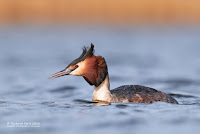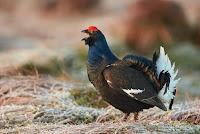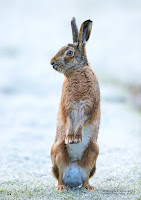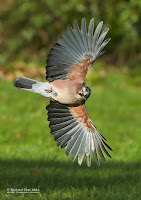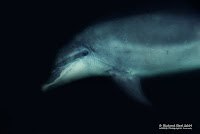This is a continuation of my previous post which saw us sat in a hide in front of a small open pool in the middle of the grassland plains of eastern Hungary. For me the star birds of the days were the storks but before I get to them an for completeness I will just post a couple of other species that visited the pond.
Late in the day a Night Heron appeared briefly. I suspect if we has stayed later into the evening more and more of these birds would have arrived. The bird landed on a log and stared with those large penetrating red eyes adapted to feeding in low light conditions.
Clearing up the remnants of fish left around the from the feeding of the large birds were a couple of opportunistic Hooded Crows. Corvids are such intelligent birds especially when there is a free or easy meal on offer.
I have seen storks previously in my wanderings around Europe but they have always been perched up high on their huge nests on a building. When I was making the plans for our trip to Hungary I had a reasonable idea of the range of species I was likely to be photographing but Storks did not appear in the list so this day was a real bonus and a treat. So I make no apology for the number of stork images to follow. We had five White Storks in front of us throughout most of the day. They are an impressively large bird with their striking colour combination of black, white and red.
We had the birds right up to the hide and peering in through the special one-way glass.
The fish is then carried to the side of the pond and repeatedly stabbed until it sufficiently subdued to be swallowed.
The white undersides of the White Storks were generally quite mud stained and one bird made a rather half-hearted attempted at bathing before moving to the side of the pond to shake the excess water off its sodden feathers.
My last photo is of one in flight and as I suspected the carrying of a baby in a blanket is a myth, unless it was just the wrong time of year for that :).
The White Storks were good but it got better as the majority of Storks in front of us were of the black variety a much less common bird. I have seen Black Storks in Zoos and have always stopped to photograph them as they have an amazing iridescence to their plumage. What a joy it was to have 17 wild birds in front of us going about their daily basis. One of the younger birds was ringed with the word 'Poland' clearly stamped on the metal band. I must admit I spent a good proportion of the day photographing these birds as I suspect such opportunities are rare. I will start of with a couple of portraits of the bird to give you an idea how beautiful they are.
Moving on to some of the action. In flight these birds are impressively large with their huge broad wings that they use for gliding on their long distance migrations. This is a juvenile and young adult birds coming in to the pond.
No fish in the pool was safe when these birds arrived and they moved en mass repeatedly from one end to the other. Fish were being captured all over and a few days of this and I expect there would not have been many left. The appetite of these birds seemed inexhaustible as one large fish after another disappeared between those bright red bills. A series of images below give a small impression of this fish eating frenzy.
As you can see from this post and the last, which only contain a proportion of the images taken on the day, it had been another amazing and productive in Hungary. As we sat in the hide in the early evening it looked like the sun was about to put in an appearance but in the distance we heard the low rumble of the 4x4 engine making its way across the plains to collect us. The sudden departure of the all the birds indicated our driver had arrived and we could finally leave the hide and back out in to fresh air. This is a day that will remain in my memory for many years to come and I felt almost numb immediately after the experience as we drove back to the hotel because the whole episode had been almost too much to take in.
Plans for the next day were made. A good meal later, a shower, images backed-up and then straight to a welcoming comfortable bed for some well earned rest before the nest day's adventures.

































































